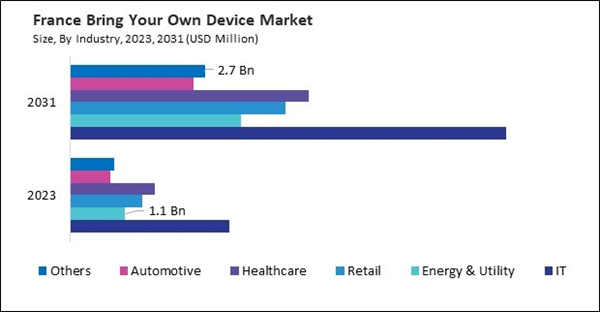The Germany market dominated the Europe Bring Your Own Device Market by Country in 2023, and would continue to be a dominant market till 2031; thereby, achieving a market value of $41.95 billion by 2031. The UK market is exhibiting a CAGR of 13% during (2024 - 2031). Additionally, The France market would experience a CAGR of 14.9% during (2024 - 2031).
The rapid development of mobile technology is one of the primary factors that is directly contributing to the expansion of the industry. The penetration of smartphones and tablets has skyrocketed, with billions owning these devices. This surge in mobile device ownership has provided fertile ground for the expansion of BYOD, as employees are now more likely to possess advanced personal devices capable of handling work-related tasks. The rise of the Internet of Things (IoT) has also played a significant role in the market's growth. IoT encompasses many interconnected devices that can communicate and share data, which are now commonly used in work environments.
The flexibility offered by BYOD is one of its most appealing aspects for both employers and employees. For employees, BYOD allows them to work from anywhere, anytime, using devices they are already familiar with. This flexibility is particularly important in the context of the modern workplace, where remote and hybrid work models are becoming increasingly common. The COVID-19 pandemic accelerated this trend, forcing many businesses to adopt remote work policies and recognize the value of flexible work arrangements. BYOD enables employees to stay connected and productive, whether working from home, in a coworking space, or on the go. This level of flexibility enhances employee satisfaction and boosts productivity, as employees can choose the tools and devices that best suit their work habits and preferences.
In France, the growth of BYOD has been closely tied to the adoption of cloud-based solutions in both the public and private sectors. The integration of cloud services has enabled employees to securely access work-related applications and data from anywhere, driving the adoption of BYOD in industries such as healthcare, education, and finance. The integration of cloud-based solutions and the increasing demand for BYOD have been further encouraged by government efforts to support digital transformation, particularly through France's"Plan de relance" recovery strategy, which emphasizes innovation and digitalization. Hence, all these developments will aid in expanding the market in the coming years.
Based on Organization Size, the market is segmented into Mid-to-Large-sized Businesses and Small Businesses. Based on Component, the market is segmented into Hardware (Smartphones, Tablets, and Laptops), Solutions (Mobile Device Management, Mobile Content Management, Mobile Application Management, Identity & Access Management, Endpoint Detection & Response, Mobile Expense Management, and Others), and Services (Professional Services {Deployment & Integration, Consulting, and Support & Maintenance} and Managed Services). Based on Industry, the market is segmented into IT, Energy & Utility, Retail, Healthcare, Automotive, and Others. Based on countries, the market is segmented into Germany, UK, France, Russia, Spain, Italy, and Rest of Europe.
List of Key Companies Profiled
- Broadcom, Inc.
- IBM Corporation
- Microsoft Corporation
- Oracle Corporation
- Citrix Systems, Inc. (Cloud Software Group, Inc.)
- Cisco Systems, Inc.
- Ivanti, Inc. (Clearlake Capital Group, L.P.)
- HP, Inc.
- BlackBerry Limited
- SAP SE
- HCL Technologies Ltd.
Market Report Segmentation
By Organization Size- Mid-to-Large-sized Businesses
- Small Businesses
- Hardware
- Smartphones
- Tablets
- Laptops
- Solutions
- Mobile Device Management
- Mobile Content Management
- Mobile Application Management
- Identity & Access Management
- Endpoint Detection & Response
- Mobile Expense Management
- Others
- Services
- Professional Services
- Deployment & Integration
- Consulting
- Support & Maintenance
- Managed Services
- IT
- Energy & Utility
- Retail
- Healthcare
- Automotive
- Others
- Germany
- UK
- France
- Russia
- Spain
- Italy
- Rest of Europe
Table of Contents
Companies Mentioned
- Broadcom, Inc.
- IBM Corporation
- Microsoft Corporation
- Oracle Corporation
- Citrix Systems, Inc. (Cloud Software Group, Inc.)
- Cisco Systems, Inc.
- Ivanti, Inc. (Clearlake Capital Group, L.P.)
- HP, Inc.
- BlackBerry Limited
- SAP SE
- HCL Technologies Ltd.
Methodology

LOADING...









